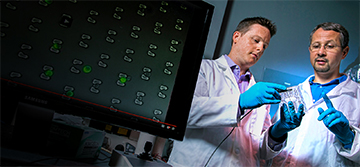
When the temperature outside freezes or swelters, we respond by putting on a sweater or eating ice cream. But when our body temperature changes, how do our cells respond?
Humans are made up of trillions of cells. Each cell has thousands of genes inside of it. Because the genes tell our cells what to do, a group of Stony Brook University researchers explored the effects of temperature change on genes. Their work offers new insights into how genes function when heated or cooled.
“When genes misbehave, they cause many diseases, such as cancer,” said Gábor Balázsi, PhD, who led the research team. “So it’s important to understand how genes control cells in different conditions.”
In the laboratory, all cells have a temperature at which they need to be maintained. Human cells have to be kept at 37 degrees Celsius, which equals 98.6 Farenheit, normal human body temperature.
“All we know about genes in human cells, we know at 37 degrees Celsius,” Dr. Balázsi said. “So we asked the basic science question: what if we switched the temperature? Would the genes still function normally, or would they act up and do something unexpected?”
Under normal conditions, genes direct cells to make many types of proteins that do a variety of jobs. So Dr. Balázsi and his colleagues looked at how this protein-making operation was affected by temperature change.
They used budding yeast cells (the same organism used to make bread and beer), because they are easier to study than human cells. Yeast cells usually are maintained at 30 degrees Celsius, but the experiments heated them up to 38 degrees Celsius and cooled them down to 12 degrees Celsius.
They found out that at high temperatures (and low temperatures too, but to a lesser degree), some cells stopped making new proteins and degraded their existing ones.
“These cells completely stopped their own growth, while eating up all their proteins,” Dr. Balázsi said.
Then there were the cells that were almost indifferent to temperature change. “They were the tough ones somehow,” Dr. Balázsi said. “They still functioned more or less normally except they grew slower.” Also, their chemical reactions slowed down at lower temperatures and went faster at higher temperatures.
The researchers noticed something else about about these tough cells in high-temperatures – some proteins took on abnormal shapes and flowed back and forth between their normal shape and their new appearance.This was an important finding, because a protein’s shape allows it to do the job it’s supposed to do.
To be able to see these cellular responses to temperature, the researchers inserted into each yeast cell synthetic biological constructs including a piece of jellyfish DNA with a particular gene in it. The gene makes fluorescent proteins. The jellyfish DNA, and whatever it is placed in, glows green when a blue light is shined on it.
The yeast cell research has implications for human health. It could serve as the basis for investigations into what happens to human genes when a person gets a high fever or is cooled down, Dr. Balázsi said.
It could also tell us more about infectious microbes. “When they go into our bodies, their temperature changes to ours,” Balázsi said. “It is important to know what that temperature change means to microbial genes, because what bugs do to us depends on what their genes are doing.”
Dr. Balázsi is Henry Laufer Associate Professor in the Louis and Beatrice Laufer Center for Physical and Quantitative Biology, and Associate Professor in the Department of Biomedical Engineering in the College of Engineering and Applied Sciences at Stony Brook University. This basic research was supported by NIH grant 1R35GM122561, and by the Laufer Center.

